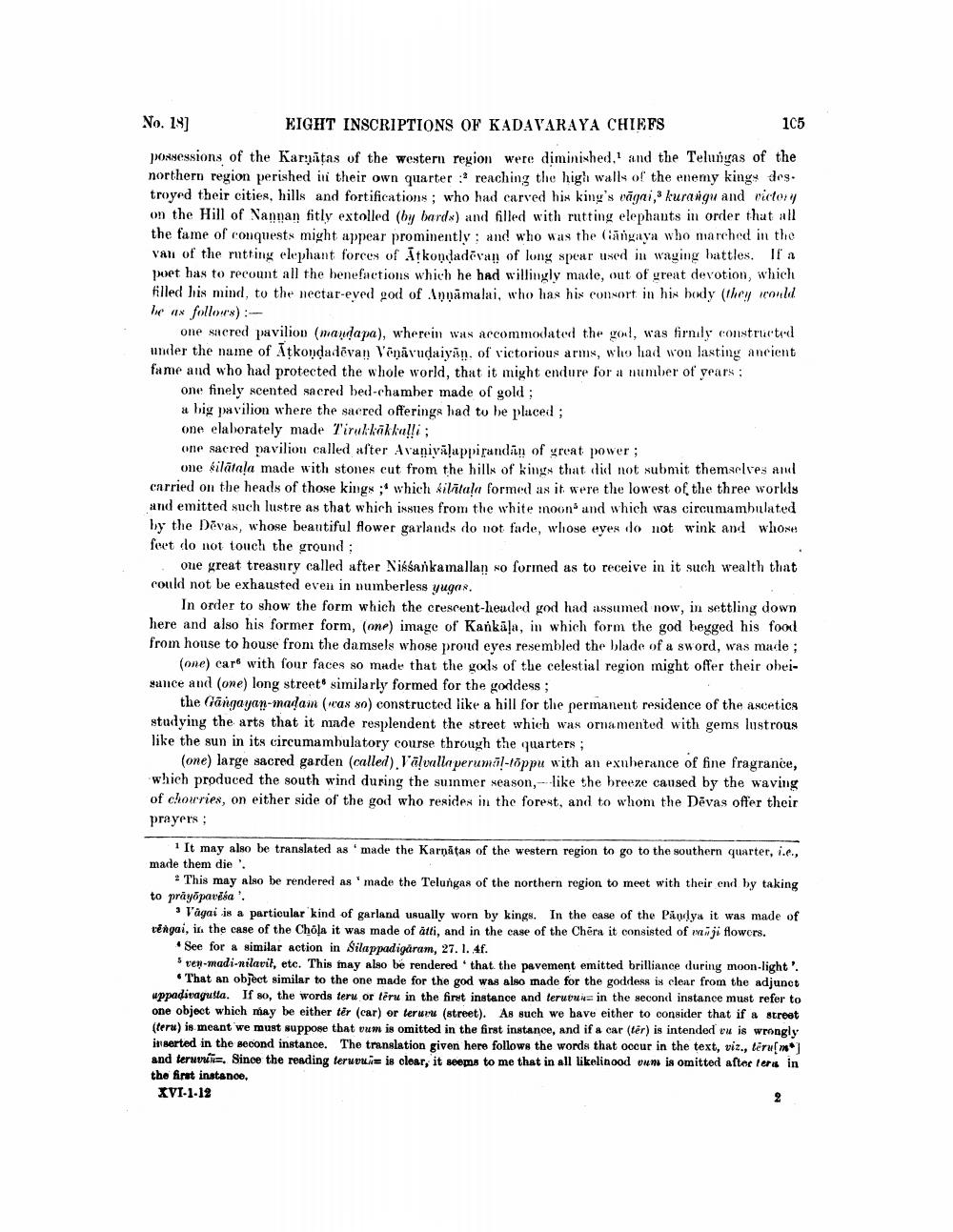________________
105
No. 19]
EIGHT INSCRIPTIONS OF KADAVARAYA CHIEFS possessions of the Karşātas of the western region were diminished, and the Telungas of the northern region perished in their own quarter reaching the high walls of the enemy kinge des. troyed their cities, hills and fortifications, who had carved his kiny's vāgai, kurangu and victory on the Hill of Nannan fitly extolled (by bards) and filled with rutting elephants in order that all the fame of conquests might appear prominently and who was the Gangnya who marched in the van of the rutting elephant forces of Atkondadēvan of long spear used in waying battles. Il a poet has to recount all the benefactions which he had willingly made out of great devotion, which filled his mind, to the nectar-eved god of Annamalai, who has his consort in his body (they could le as follows) :
one sacred pavilion (mandapa), wherein was accommodated the yol, was firnily constructed under the name of Atkondadovan Vināvudaiyan. of victorious arms, who had won lasting ancient fame and who had protected the whole world, that it might endure for a number of years:
one finely scented sacred bed-chamber made of gold; a big pavilion where the sacred offerings had to be placed ; one elaborately made Tirukkūkkal!i; one sacred pavilion called after Avanivalappirandin of great power;
one silāta!a made with stones cut from the hills of kings that did not submit themselves and carried on the heads of those kings' which filatala formed as it were the lowest of the three worlds and emitted such lustre as that which issues from the white rnoon and which was circumambulated by the Devas, whose beantiful flower garlands do not fade, whose eyes do not wink and whose feet do not touch the ground;
oue great treasury called after Nissankamallan so formed as to receive in it such wealth that could not be exhausted even in numberless yugar.
In order to show the form which the crescent-headed god had assumed now, in settling down here and also his former form, (one) image of Kankāla, in which form the god begged his food from house to house from the damsels whose prond eyes resembled the blade of a sword, was made ;
(one) cars with four faces so mude that the gods of the celestial region might offer their obeisance and (one) long street similarly formed for the goddess;
the Gangayan-madam (wax so) constructed like a hill for the permanent residence of the ascetics studying the arts that it made resplendent the street which was ornamented with gems lustrous like the sun in its circumambulatory course through the quarters
(one) large sacred garden (called). Vāļuallaperumal-tõppu with an exuberance of fine fragrance, which produced the south wind during the suinmer season,-- like the breeze caused by the waving of chouries, on either side of the god who resides in the forest, and to whom the Devas offer their prayers:
1 It may also be translated as made the Karnatas of the western region to go to the southern quarter, i.e., made them die
* This may also be rendered as made the Telungas of the northern region to meet with their end by taking to prayopavēša!
• Vägai is a particular kind of garland usually worn by kings. In the case of the Pandya it was made of tengai, in the case of the Chola it was made of atti, and in the case of the Chere it consisted of viji flowers.
• See for a similar action in Silappadigaram, 27. 1. 4f. Sven-madi-nilavit, etc. This may also be rendered that the pavement emitted brilliance during moon-light'.
• That an object similar to the one made for the god was also made for the goddess is clear from the adjunct uppadivagutta. If so, the words terw or feru in the first instance and teruuia in the second instance must refer to one object which may be either tér (car) or ter um (street). As such we have either to consider that if a street (teru) is meant we must suppose that rum is omitted in the first instance, and if a car (ter) is intended ou is wrongly inserted in the second instance. The translation given here follows the words that occur in the text, viz., teru[m ] and teruvia=. Since the reading terwouis is clear, it seems to me that in all likelinood one is omitted after ter in the first instance,
XVI-1-12




